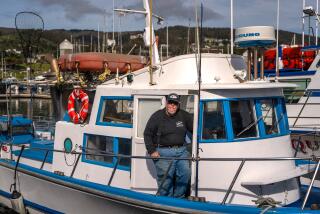A Vanishing Breed on the Great Lakes : Midwest Commercial Fishermen Battle Sports Anglers to Make a Living
- Share via
DULUTH, Minn. — Milford Johnson stoked the Caterpillar engine in his 30-ton fishing tug and blasted through half a mile of ice to the churning open waters of Lake Superior. It’s as rugged a commute as you’re likely to find.
“It’s got the steel hull so you can really rap it,” Johnson yelled.
Behind the wheel of the A. E. Clifford, in his winter overalls and wool cap, the 60-year-old Johnson is a relic. When he and about 15 other aging commercial fishermen call it quits, the Minnesota waters of Lake Superior will be nearly barren of men who make a living off gill nets.
“This type of fishing is really getting choked off,” said Johnson, who has weathered the industry’s steady decline since its heyday in the 1940s. “There’s no incentive. You can’t build boats like this anymore and go out and pay for them. They’re going to eliminate you with the economy.”
Minnesota’s 1.4 million acres of Lake Superior, once dominated by rugged professional fishermen of Scandinavian descent, are now ruled by sports anglers from all over the Midwest.
More Fragile
Minnesota’s commercial fishery is smaller and more fragile than its counterparts in Wisconsin, Michigan and Ontario. But the trend is the same, said Jeff Gunderson of the University of Minnesota Sea Grant Extension Program.
“It’s a national trend that’s moving toward sports fishing,” Gunderson said. “I guess the problem is trying to work it out so they can coexist. These types of things are usually won by sports fishermen.”
The number of full-time commercial fishermen in Minnesota has dwindled from the 200 of 40 years ago to fewer than 20. The 1988 total catch was worth less than $200,000, said Steve Morsey, the state Department of Natural Resources’ acting fisheries supervisor for Lake Superior.
Meanwhile, the number of sports charter-boat captains has doubled since 1985, from 32 to 67, generating an estimated $2.5 million in local spending on the North Shore in 1988.
“I think the handwriting is on the wall,” said Floyd A. Hennagir, fisheries program coordinator for the DNR. “You keep reducing the commercial fishermen to the point where they don’t have any monetary clout or political clout and they just kind of fade away like old soldiers. There isn’t much you can do about it. We’re controlled by public sentiment.”
Such sentiment is keeping commercial fishermen away from lake trout--which would yield $1.50 a pound compared to 30 to 50 cents for other Lake Superior fish--because they are the bread and butter of the sports fishing industry.
“They think that playing with the fish is more important than producing it for food,” said 75-year-old Stanley Sivertson of Duluth, a lifelong commercial fisherman who owns the Clifford and another large fishing tug. Such boats would cost $90,000 today.
Commercial trout fishing has been largely banned since the early 1960s after the population of the prized species dropped off sharply, mainly because of growing numbers of parasitic sea lamprey. Commercial fishing “was the straw that broke the camel’s back,” said Hennagir.
Annual Catch
According to DNR records, the largest annual commercial catch of lake trout from the Minnesota waters of Lake Superior was in 1885, when 1.3 million pounds were harvested. The catch routinely exceeded 300,000 pounds a year from 1921 to 1947, but fell to 11,000 pounds by 1960.
But Sivertson and other commercial fisherman say they had nothing to do with the decline of lake trout. They blame the lamprey, herring and fry-eating smelt, which they contend were planted in the Great Lakes during the 1940s as food for salmon imported for sports angling. Morsey said the smelt escaped from inland lakes in Michigan.
The trout population has been rejuvenated with the stocking of 1.8 million yearlings and fingerlings since 1983 and a lamprey control program. Sivertson and other commercial fishermen say an end to the ban would help them.
“There’s more trout now than I’ve ever seen,” said Sivertson. However, he and others admit that the prospects are dim because of the sportsmen.
Without trout, commercial fishermen are left to rely on smelt, ciscoes, whitefish and herring. In 1987, they netted 195,000 pounds of smelt, 112,300 pounds of herring and 3,000 pounds of ciscoes valued at about $138,000. Another $49,500 came from the incidental catch of 2,000 pounds of lake trout and 30,000 pounds of trout caught under a handful of special permits issued to help the DNR monitor the population of the species.
In the 1940s and earlier when there were as many as 200 fishermen, single boats would haul in 15 to 20 tons of fish a day, Sivertson said. Nowadays, an excellent day will yield half a ton of fish--the maximum amount that can be processed in the scaled-back, on-shore production houses.
More to Read
Sign up for Essential California
The most important California stories and recommendations in your inbox every morning.
You may occasionally receive promotional content from the Los Angeles Times.













